Claussen Pickles are kosher dill pickles at their crunchiest, saltiest best! These homemade Claussen pickles taste like the commercial ones you find at the store, but better. And better yet, they’re ridiculously easy to make!
Whether you’re new to pickle making or a pickle veteran, you NEED to make these half sour pickles! And wonder of wonders, you don’t need to know how to can to make these super fresh, crunchy pickles! Claussen dill pickles are meant to be eaten fresh.
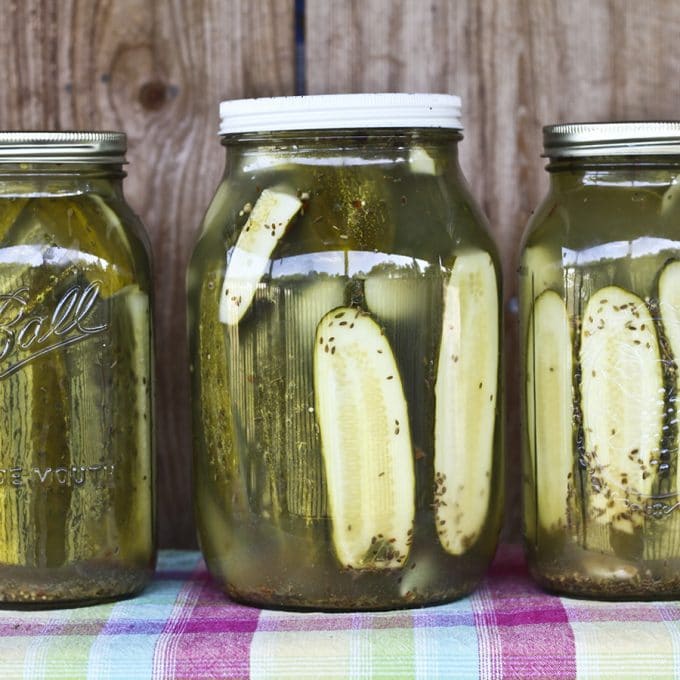
Homemade Claussen Knock-Off Pickles: Always crunchy and garlicky, this perfect homemade pickle recipe requires no special equipment, & no canning experience.
It’s common knowledge that I have a salty tooth rather than a sweet tooth. When the weather does what it has been doing lately (making us all do our best Shadrach, Meshach and Abednego impersonations) I can’t think of a single thing I find more refreshing than an icy-cold, salty, crunchy pickle.
It’s not just me, it’s my whole family: mother, sisters, brothers, cousins, aunts, grandparents, kids, husband… I married a man who loves pickles so much he eats the pickles and then drinks the juice from the jar.
I grew up eating my Grandma’s homemade dill pickles like the supply was endless and moved on to canning my own pickles as soon as I had a kitchen of my own. There’s just something about a homemade dill pickle that makes me happier than any pickled cucumber ever should.
My little sister, Jessamine, and I compare our homemade pickles from year to year the way some people compare wine vintages.
Dill Pickle Recipe
But there is one pickle that stands head-and-shoulders (were pickles to *have* heads and shoulders) above all others. I’m talking about the pickles you see here. That’s right: Homemade Claussen Dill Pickles.
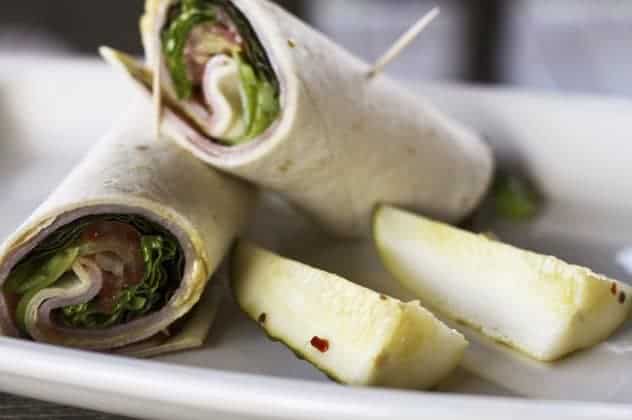
Recipe for Claussen Pickles
What do you need in order to make this recipe for Claussen Half Sour Pickles at home? Let’s get a quick list for both ingredients and equipment out of the way, shall we?
Equipment for Making Claussen Pickles at Home
- A Glass gallon jar or 4 glass quart jars or other food safe container with a tight fitting lid
- Measuring cup
- Chef’s knife or paring knife
Ingredients for Making Homemade Claussen Pickles Copycat
- Small to medium size pickling cucumbers (check your local farm stand or farmer’s market!)
- Apple Cider Vinegar (don’t fret- it doesn’t taste like apple cider and isn’t even a little sweet!) or white vinegar
- Kosher Salt
- Garlic
- Dill (either fresh or dill seed)
- Pickling spices (available here)
A quite note on your vinegar choice: I opt for apple cider vinegar because it’s a smoother vinegar than white vinegar. It does not impart any sweetness or apple taste to the pickles whatsoever.
If you can’t find it (pssst. It’s right next to white vinegar in even moderately stocked grocery stores) or don’t feel like buying it, you can most certainly substitute white vinegar. It’ll just taste a little sharper. (And technically store bought Claussen pickles have white vinegar, so you do you!)
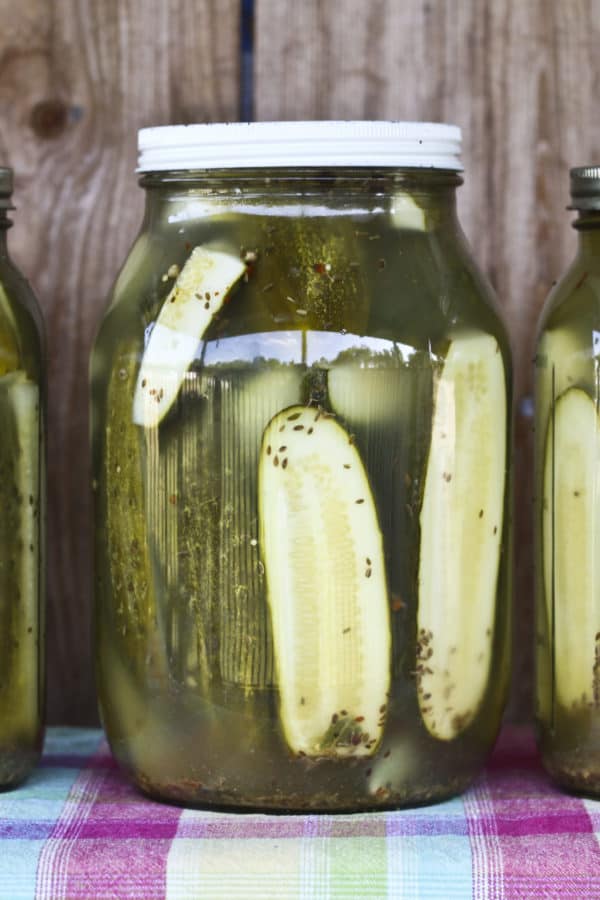
And ya’ll. These homemade half sour pickles are so easy to make it’s almost criminal.
The hardest part is the 2 to 4 day wait for them to be done. Truth be told, though, I’ve snacked on them the day after I made them and been a very happy camper.
Claussen Pickle Recipe
These are homemade refrigerated deli pickles, also known as Lithuanian half-sours, also known (in the commercial equivalent) as Claussen dill kosher pickles, also known as the best pickles ever known to mankind.
Here’s the thing. While I do love my other homemade pickles dearly (otherwise why would I continue canning ninety-something quarts year after year after year), these are by far my all-time favourites.
CRUNCH. That’s what you hear when you bite these. There is no flop, no squish, no soft pickles. These things almost bite back.
This also happens to be the perfect dill pickle recipe for beginning pickle makers. If you’re not into canning, these refrigerator pickles are a godsend. Even if you ARE canning obsessed, like yours truly, this Claussen pickle recipe should be in your pickle repertoire too.
Please note that this Claussen pickle recipe is not suitable for canning. The brine is fermented and not very acidic, which means it has far too high a PH to can safely. If you’re looking for a great canned dill pickle recipe, try this home canned garlic dill pickle recipe.
Refrigerator Pickles
Here’s where we get into the best part of this pickle recipe (aside from the crunch and flavor). You don’t have to cook anything to make these pickles; not one single thing. The brine is stirred together, the cucumbers are rinsed, trimmed and stuffed into a jar with garlic cloves and spices.
These half sour pickles are NOT CANNED. They are simply put into jars. Amen!
When it’s summer time and the idea of turning on the stove makes me want to crawl into an (air conditioned) hole, these pickles are a welcome treat. Not only is that cold crunchy refrigerator pickle waiting to cool me off at the end of the prep time, but I don’t have to heat up my kitchen by even one single degree to get there.
Remember that pickling isn’t just for cucumbers, either! Try out our Pickled Brussels Sprouts, Quick Pickled Red Onions, and famous Candied Jalapenos!
How to Make Pickles FAQ
Please, please, please give these a go even if you have never made a pickle before. There is nothing scary or intimidating here. Wash, slice, stuff, stir, pour, sit, wait.
- Trim 1/8-inch from the blossom end of each cucumber and slice them in half lengthwise or into quarters. The size you choose depends on how large your cucumbers are and how big you want the pickles to be when they’re done. This helps minimize the chances of soft pickles.
- In a gallon jar (or large, wide-mouth, food-safe container) layer the dill heads or seed, pickling spice or mustard seed, and garlic cloves and sliced cucumbers. If you’re dividing the cucumbers up between smaller containers, just divide the garlic and spices evenly between the containers, too.
- Stir your brine together in a separate container. You WILL have more brine than you have space for in the jars, but that’s why you pack the spices in the jars. Just store extra brine in a jar in the refrigerator and use it to top off your pickles if the brine starts evaporating.
- Pour the brine over the cucumbers, taking care to make sure all of them are fully submerged. If needed, place a plate or mug or other ziploc bagged can of beans on the cucumbers to weigh them down and keep them under the brine!
- Cover the jars lightly not tightly and leave out of direct sunlight on the counter for two to four days or until the pickles are picklicious.
- If your kitchen is pretty hot or humid, you can stash them directly in the refrigerator. They’ll just take a couple of days longer to get fabulous. Your patience will be rewarded.
On the plus side, the wait is only two to four days which is significantly less than the six week wait of the canned pickles. Besides, as I said, there is the crunch factor
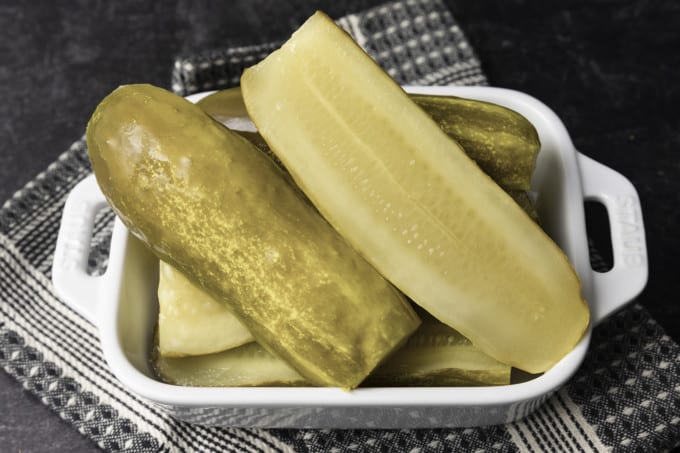
Troubleshooting Your Homemade Claussen Pickles
These pickles are easy peasy to make, but there still may be a couple of things that pop up from time to time that make you go “Hmmm…” In no particular order, here are some of the most commonly asked questions about them and some answers!
- Why is my pickle brine cloudy? Okay, I lied. This is the most common question and that’s because the brine becomes cloudy naturally as a consequence of fermentation (which is what’s happening here.) No worries.
It’s all natural. This half sour pickle recipe (more on this to come) is a fermented pickle recipe and that just happens.
Another possible cause of intense cloudiness or discolouration in your brine is using table salt. The iodine in table salt can also give off flavours to your pickles, so it’s best to stick with kosher salt or pickling salt for these bad boys! - Is the scum, foam, or film on top of my pickle brine dangerous? It’s that pesky (and delicious) fermentation again! This is another thing you don’t have to worry about.
Just scrape it off with a spoon, discard, and top off with a little of that extra brine you whipped up. (See the recipe card for details.) But do remove the scum or it could cause your pickles to go bad. - My pickles went soft! How do I prevent this? This particular tragedy could have two causes.
First, you may have failed to remove enough of the blossom end of the cucumber. There is a naturally occurring enzyme in the blossom end of cucumbers that causes pickles to break down and become soft if it is not removed. Next time, just slice more off.
Second, you may have started with less than spectacularly fresh cucumbers. An older cucumber has had longer for the aforementioned enzyme to kick in, and it has already started its work.
The best solution for this issue is to use cucumbers that have either been picked fresh that day or have been refrigerated steadily since very shortly after being picked a couple of days previously. - Why did my pickles go bad? See that second reason in the “why did my pickles go soft” bullet point? That’s one culprit.
Other potential causes of spoiled pickles are using unwashed cucumbers or fresh dill, old or decayed garlic, bad spices, lower-than-5%-acidity-vinegar, failing to remove the scum from the brine or to keep the pickles submerged in the brine, or storing your pickles in warmer conditions. When in doubt, stash them in the refrigerator! - Why is there mold on my pickles? First, you have my condolences. Second, it’s because your pickles didn’t stay submerged in the brine. That brine has enough salt and acid to prevent mold growth if the cucumbers stay under the surface.
If you’re having trouble finding something that fits in the jar to keep this from happening, try popping a can or two of tomato paste or canned beans in a zipper top bag and gently inserting that into the jar. It should weigh it down enough to do the job. - Should I worry about the white sediment in my jar? This is another one in the “don’t sweat it” category. There are two potential reasons and both are completely harmless.
It’s either a natural consequence of the fermentation or anti-caking agents in the salt. Neither harms the pickles or effects the flavour, so don’t worry! - Why is my garlic blue/green/purple? As long you inspect the garlic before it goes into your jars and it is fresh as a daisy, you have nothing to worry about. It could be the type of salt you used or it could be the variety of garlic. Some types of garlic have a natural propensity to change pretty colours in vinegar.
It also may mean that your pickles were exposed to light. When garlic is exposed to light, it starts producing chlorophyll which is green. It also may indicate that your garlic is more mature.
In that case it is caused by sulfur compounds that naturally occur in more mature garlic reacting with minute traces of copper in the vinegar., but as long as there are no other signs of spoilage (soft or squishy texture, funky smell, discoloured spots), you’re good to go.
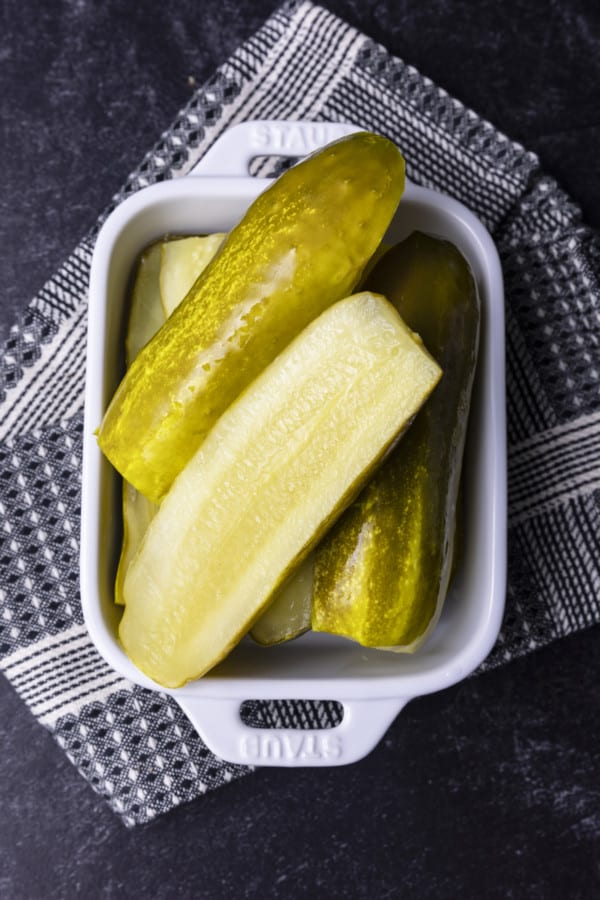
IMPORTANT NOTE: Because there is so much diversity in temperature, humidity, age of cucumbers, etc… involved in this recipe, please check your half sour pickles starting at 24 hours for doneness. If the pickles smell/taste pickley, move them to the refrigerator. Do not keep them on the counter longer than 4 days.
ANOTHER IMPORTANT NOTE: These pickles are not suitable for canning. They’re simply not acidic enough to can safely, and that is in addition to the fact that you’d ruin that perfectly crisp texture by introducing heat to the party.
What can I serve with these Homemade Claussen Knock-Off Pickles?
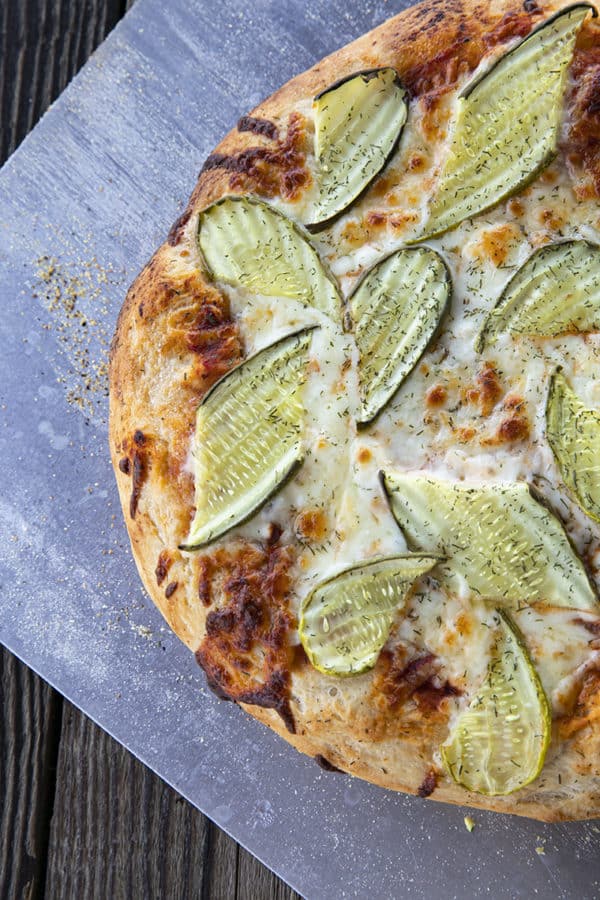
Start out by trying your half sour pickles in this Pickle de Gallo, Dill Pickle Dip, Dill Pickle Egg Salad, or Bagel Burgers with Dill Pickle Cream Cheese.
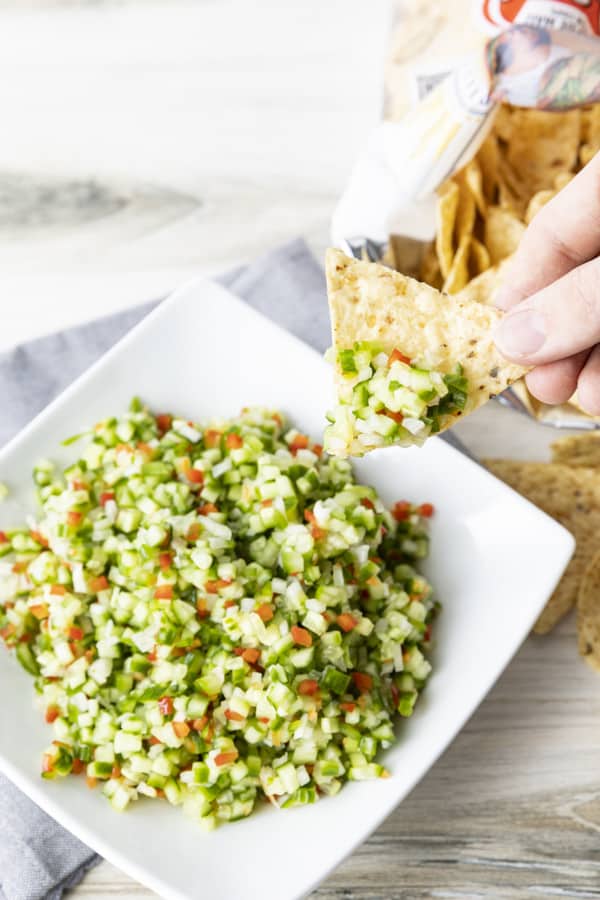
Even better, serve them on our Cheeseburger Salad or Pickle Pizza.
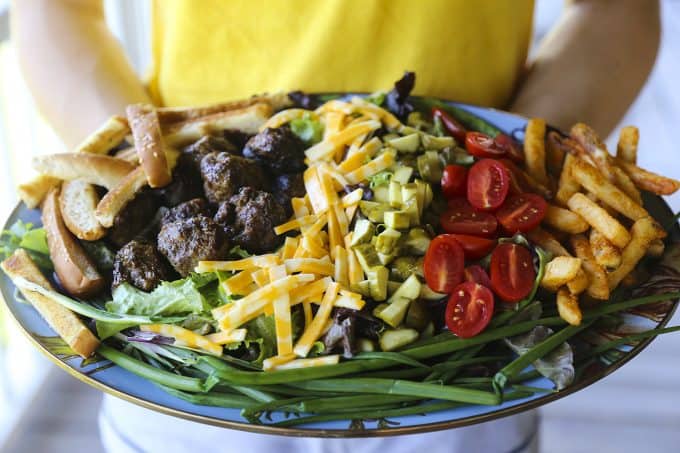
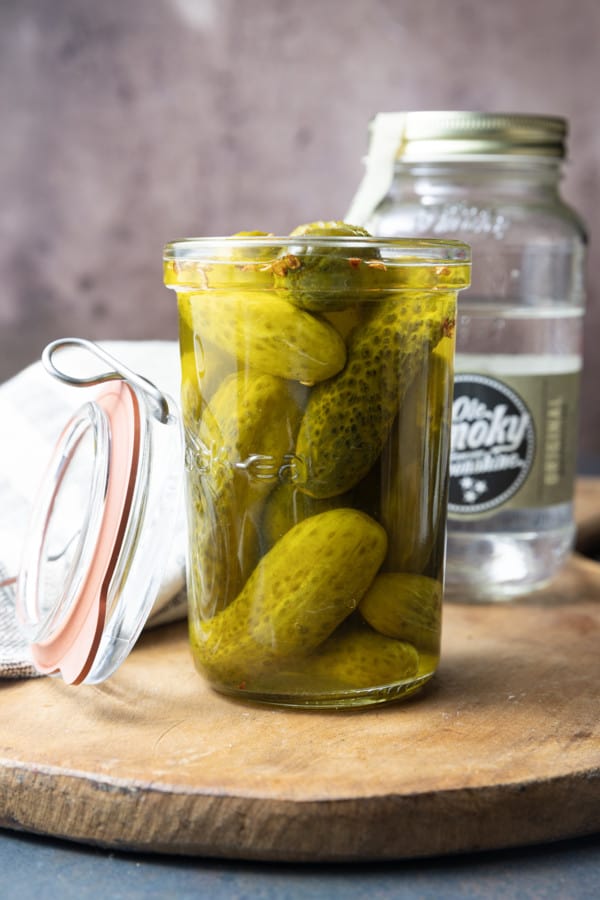
You can even take extra pickles (like that’s a thing!) and make these divine Moonshine Pickles. You’ve never had a better Bloody Mary than one made with homemade Moonshine Pickles!
Half Sour Pickle Recipe
What makes Claussen PIckles different from canned pickles? Claussen pickles, whether homemade or store bought, are a half sour pickle recipe.
That means they’re fermented instead of heat processed. That’s what gives them such great texture.
This half sour pickle recipe yields pickles that are crunchy to the point of making noise when you bite them, cold, and seriously garlicky. Canned, shelf-stable pickles can be chilled, maintain some crunch, and be as garlicky as you want them to be, but they are never, ever going to be the same thing because of science.
When you heat process a jar of pickles you are, in actuality, cooking it and a cooked pickle just plain can’t be as crunchy as an un-cooked half sour pickle recipe.
These homemade pickles keep well in the fridge for about six months, as long as they remain submerged in the brine. In our house, they never last that long because, as the saying goes, “A pickle a day keeps sad times away.”
They say that right? Someone must. If not, I’m going to start. It’s true, after all.
Claussen Pickles
Wash cucumbers but do not scrub them.
Trim 1/8-inch to 1/4-inch from the blossom end of each cucumber and slice in half lengthwise or into quarters, depending on how large your cucumbers are and how big you want them to be when they’re done.
Layer the dill heads or seed, garlic cloves, pickling spices and sliced cucumbers in a gallon jar (or large, wide-mouth, food-safe container). You can evenly divide the dill, garlic cloves, pickling spices, and cucumbers between several smaller jars if needed.
In a separate pitcher or bowl, stir together the remaining ingredients until the salt is dissolved.
Pour the brine over the cucumbers, taking care to make sure all of them are fully submerged. If needed, place a plate or mug or other non-reactive heavy item on the cucumbers to weigh them down and keep them under the brine!
Cover lightly with a lid just perched on top or secure a piece of cheesecloth over the jar with a rubber band to keep fruit flies away. Store any extra brine in a covered jar or pitcher in the refrigerator and use it to top off the brine if it starts to evaporate and expose the pickles to the air.
Leave out of direct sunlight on the counter for at least 24 hours, but up to 4 days, or until the cucumbers taste like pickles throughout.
Fix your lid onto your jar or container and chill thoroughly. These can be stored in the refrigerator for up to six months provided you keep them covered with brine.
NOTE: If at any point in the proceedings “fuzz” or “foam” develops on top of the brine, use a spoon to remove it. If there is “fuzz” attached to any of the cucumbers, remove the ones affected and be sure the others are still fully submerged.
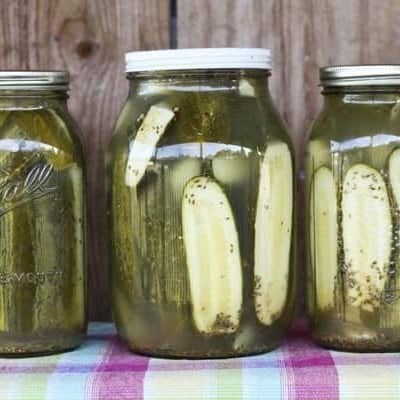
Homemade Claussen Knock-Off Pickles
Equipment
- 1 gallon jar or 4 quart jars or a large, food-safe container with a tight fitting lid
- 1 liquid measuring cup
- 1 large mixing bowl or pitcher
Ingredients
- 35 to 40 small to medium pickling cucumbers
- 1 gallon cold water
- 1 cup apple cider vinegar, preferably raw or white distilled vinegar
- 2/3 cup coarse canning or kosher salt Do NOT fine or use iodized salt!
- 4 cloves garlic or more to taste
- 4 heads fresh dill or 4 tablespoons dried dill seed not weed!
- 2 tablespoons mixed pickling spices
Instructions
- Wash cucumbers but do not scrub them.
- Trim 1/8-inch from the blossom end of each cucumber and slice in half lengthwise or into quarters, depending on how large your cucumbers are and how big you want them to be when they’re done.
- In a gallon jar (or large, wide-mouth, food-safe container) layer the dill heads or seed, garlic cloves, pickling spices and sliced cucumbers.
- In a separate pitcher or bowl, stir together the remaining ingredients until the salt is dissolved.
- Pour the brine over the cucumbers, taking care to make sure all of them are fully submerged. If needed, place a plate or mug or other non-reactive heavy item on the cucumbers to weigh them down and keep them under the brine!
- Cover lightly with a lid just perched on top or secure a piece of cheesecloth over the jar with a rubber band to keep fruit flies away.
- Leave out of direct sunlight on the counter for two to four days*, or until the cucumbers taste like pickles throughout.
- Fix your lid onto your jar or container and chill. These can be stored in the refrigerator for up to six months provided you keep them covered with brine.
- *If at any point in the proceedings “fuzz” or “foam” develops on top of the brine, use a spoon to remove it. If there is “fuzz” attached to any of the cucumbers, remove the ones affected and be sure the others are still fully submerged.
Notes
Nutrition
Nutritional information is an estimate and provided to you as a courtesy. You should calculate the nutritional information with the actual ingredients used in your recipe using your preferred nutrition calculator.
did you make this recipe?
Make sure to tag @foodiewithfam on Instagram and #hashtag it #foodiewithfamily so I can check it out!
Originally published July 22, 2011. Updated with FAQs and Troubleshooting and reposted August 2022.
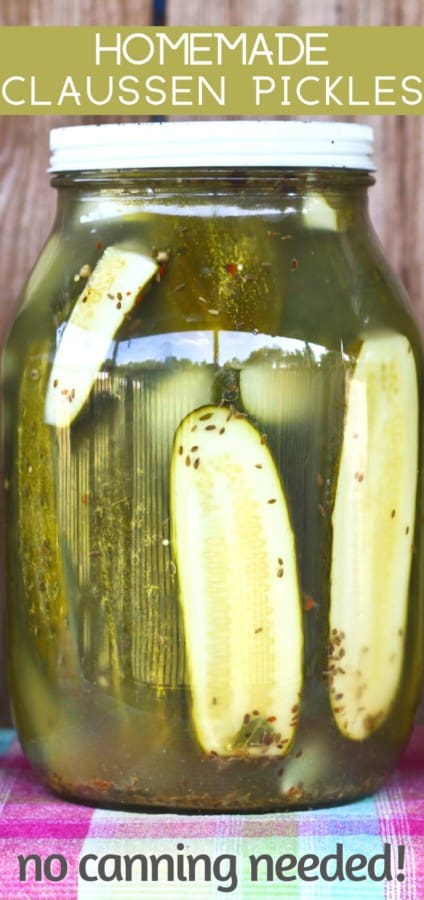
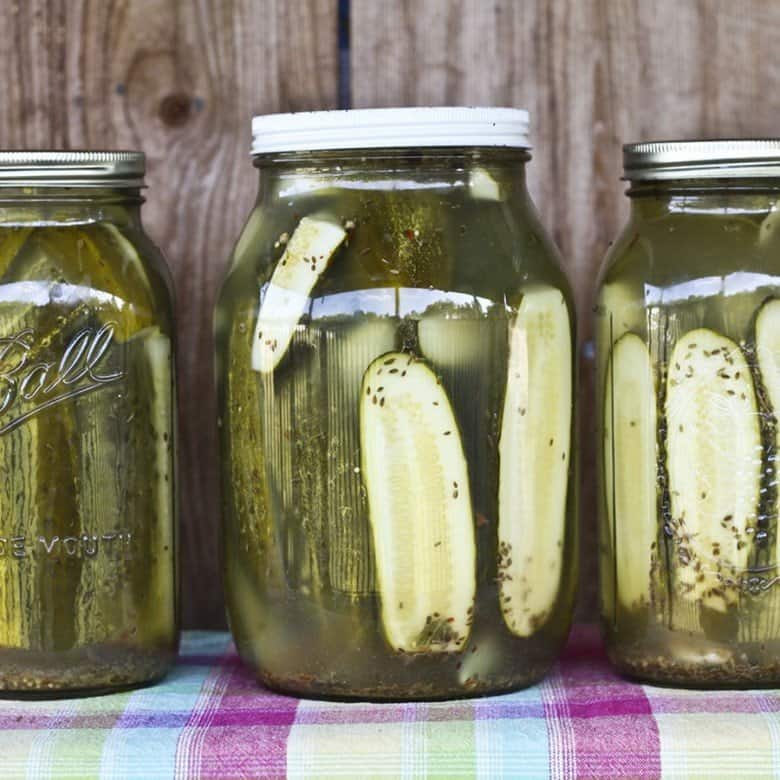
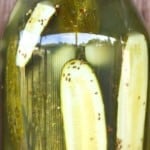



Reader's Thoughts...
Grover T Duffield says
Could you use this for pickled eggs? I am trying to find a clearer brine.
Rebecca says
Hey there, Grover. I think after you’ve pickled cukes in it, it would be lovely for eggs. I’m not sure if it would be sufficient to pickle it before it’s gone through the fermentation process with the cucumbers in it, though.
Anna says
I just made these tonight. Hopefully they turn out well. I used 2 of the extra large canning jars which are actually to large to use if you’re processing anything. 4 other jars of pint and a half. The pint and a half are also freezer safe. I’m wondering after they sit out for, 4 days if they would keep longer if you freeze them?
Thanks
Rebecca says
Hi Anna- I wouldn’t freeze them as I’m thinking that will be very likely to make your pickles mushy. Enjoy your pickle bounty!
Anna Eastman says
Yes, thanks I was wondering about that mushy business too.
My Amish cousins make freezer pickles for when they host church but they are sweet and sliced very thin. They are good but I love these garlic Dill better.
Denise Freitas says
I made these last summer with the abundance of cucumbers from our garden. They were easy and the end result was enjoyed by all. I will either make my own pickling spice to leave out the cloves. While the cloves are not unpleasant, they just ad a flavor that I do not associate with refrigerator dill pickles. Clove goes with sweet pickles to me. Anyway, as the jars aged in the refrigerator (I had a 2 recipes), the brine became a bit “boozy”, not cloudy or fuzzy, just a bit bubbly. I’ll use this recipe again.
I do have a question for you, have you ever used this recipe and then processed in a low temperature hot water bath to have a shelf stable pickle? While I have a second refrigerator, I’d like to have a shelf stable version as well. For a third batch of pickles, I tried another recipe that I found and had high hopes for the results. BUT, the end result was a pickle so salty that we couldn’t eat them.(https://www.youtube.com/watch?v=7MKGTCj4GXc) The low temperature canning recommendations come from National Center for Home Food Preservation, http://nchfp.uga.edu/how/can_06/low_temp_pasteur.html.
I’d love to hear your thoughts.
Rebecca says
Hey Denise-
I’m so glad you love these pickles. I love them, too. I’m afraid this recipe is not suitable for canning because of low acidity. It’s the acidity that really cinches it, unfortunately, and that’s one of the hallmarks of the flavours of this pickle.
Denise Freitas says
thanks for your reply. I will make your recipe again and will continue to pursue a shelf stable kosher dill.
Melissa Griffiths says
I made this recipe just as directed and they turned out PERFECT! I’m dreaming of garden cucumbers so that I don’t have to buy them next time. SO great.
Rebecca says
Wheeeee! I’m so glad you loved them!
Dorothy Morgenstein says
I love you recipe; however, I need to divide into 1/4 so I can make 2 quarts at a time. Could you help me figure out how much of ingredients? I’d appreciate your help! Sincerely, Dorothy Poki’i
Tina says
Where would I buy mixed pickling spices?
Bruce Krahn says
Add alum for extra crunch.
Rebecca says
I’ve never used alum in fermented pickles. I wonder how it would work out.
Deborah says
What is the correct portion to make the brine for 2 quarts and 4 pint jars.
Deborah says
Day 1,and I tasted my pickles and it was a little salty. What can I do to save them or will the taste change the longer they stay in the brine.
PLEASE HELP ME! !!!!!
Rebecca says
The taste changes for sure. Did you use Morton’s coarse kosher salt or another salt?
Deborah says
Yes I used Morton coarse kosher salt.
EZChef says
You MUST weigh the salt & water, to arrive at the right percentage solution.
The same volumes, of table salt or Morton Kosher salt or Diamond Crystal Kosher salt, will all weigh different amounts.
Richard Halsey says
Hi Rebecca, I’ve been making Claussen knock-off pickles for years, but I lost my original recipe, and last year’s batch did not turn out very well. So I’ve been looking at a lot of copycat recipes. I notice that many have a ration of about .25 cup salt, 1 cup vinegar, 3 cups water. Yours is much more diluted, with .66 cups salt, 1 cup vinegar, 1 gallon water. Any thoughts or info on the variation of brine strength?
BTW, I use green tomatoes instead of cukes. Claussen used to sell them, but not any more.
EZChef says
The only consistent way to measure salinity is by weight:
To 1 liter of water (1,000 gm), you add:
20 gm of salt, for a 2% solution,
35 gm of salt, for a 3.5% solution,
40 gm of salt, for a 4% solution,
50 gm of salt, for a 5% solution,
Etc.
I just made a batch, with a 5% solution, and it came out very good. Lacto fermentation generates its own acidity, but I’ll add some cider vinegar, for flavor, after I refrigerate the jars.
Richard Halsey says
Thanks EZChef for this information! Now I can more accurately compare recipes. The batch I made last week was apparently about 7.5% salinity, which I subsequently learned, is close to commercial strength brine.
EZChef says
Give Us Feedback: Let us know, what brine strengths and curing times you have tried, and how your pickles turned out. That way, we can find the optimal recipe.
Richard Halsey says
7.5%, and 6 days on the kitchen counter (turned daily) produced a very good result.
EZChef says
I just made a jar of pickle spears, with a 6% brine, and they tasted Good, after only two days of curing.
Jill Ziemski says
I was so excited to make these pickles and am quite proud of my jars! I tried one yesterday, after three days of sitting, and it was awfully salty. 🙁 Will this change while they sit and refrigerate?
Christy Raymond says
Why not dill weed instead of dill seed?
Rebecca says
There are a couple of reasons. First and most importantly, the dill seed provides a deeper, stronger dill flavour than the frondy weed/leaves. The seeds have a more traditional “pickle” flavour. That’s why when using fresh dill, you put in the seed heads. Second, the leaves/weed tend to cling to everything and float unpleasantly in the pickle brine while the seeds settle helpfully to the bottom for the most part.
Bob Stewart says
Very close to the cold water pickle recipe from my Mother in law, her’s also had one small dried red pepper I’ve used red pepper flakes. Her best tip for crisp crunchy dill pickles is to NEVER use Chlorinated water, if I’ve had great success with distilled water (make sure it’s distilled as bottled water can contain Chlorine).
Kathi says
There are bubbles on the top of the pickles in the jar. Do I need to remove them. Not foamy of fuzzy, just bubbles
Rebecca says
Bubbles are fine: no worries!
EZChef says
The bubbles are carbon dioxide – evidence of healthy fermentation.
Brenda says
Perfect! And easy! I used an abundance of garden fresh zucchini, garlic, and hot peppers, as well as cucumbers in this recipe and it all tasted wonderful.
Tera says
Can you put these in smaller jars..or do the pickles need the entire brine?
Rebecca says
You can definitely put them in smaller jars, just distribute the pickling spice, dill, and garlic cloves evenly before pouring in the vinegar, salt, water mixture.
Carolyn Gidyk says
These are the best pickles! I’ve made several varieties over the years and these ones are by far the simplest AND the tastiest. Thank you for sharing this recipe!!
Debbi says
I am confused. Does this recipe make 1 gallon of pickles? If so, where does all the water go? I assume it is to be included as part of the brine. If I am wrong please let me know.
Rebecca says
Hi Debbi-
There will be extra brine, but you can store it in the refrigerator to top off the crock or jars of pickles if any of it evaporates. The water IS part of the brine. It’s one of the “remaining ingredients” to mix together in the pitcher. 😀
Bassam Ahmad says
Have you tried making fermented pickles? The procedure is similar except the brine only consists of 1 tbsp kosher or sea salt to 1 cup of filtered or distilled water. You leave the container of pickles on the counter to ferment for 9 days. No vinegar is necessary because the fermentation process creates lactic acid.after 9 days of fermentation you store pickles and refrigerator. These are by for the best and crunchiest pickles I have ever made and they taste much like Clausen. They’re also beneficial because they contain helpful bacteria which is good too replenish your intestinal Flora similar to the effect of eating yogurt.
Dianna Blumrick says
I love pickles. Thanks for your recipe. Do you have good bread & butter pickles too. Thank you.